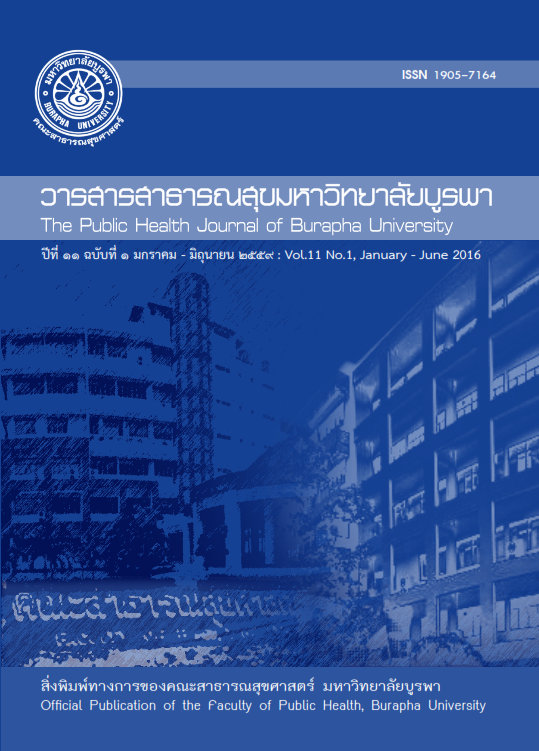ความชุกและปัจจัยที่มีความสัมพันธ์กับการเกิดอุบัติเหตุเข็มตำและหรือของมีคมบาด ขณะปฏิบัติงานของผู้ปฏิบัติการอาสาสมัครกู้ชีพเบื้องต้น
Main Article Content
บทคัดย่อ
Prevalence and Factors Associated with Needle Stick and/or Sharp Injury during Working among Medical First Responders
This cross-sectional survey was attempted to assess the prevalence and factors associated with needle stick and/or sharp injury (NSI) among medical first responders (MFRs) during working. Totally 344 MFRs working in the fifth public health region of Thailand were carried out. All voluntary MFRs who aged 18 years and over, male and female were interviewed using a structured questionnaire consisting of socio-demographic factors, working experience, 3-month history of NSI during working, and universal precaution (UP) practices. Data were analyzed by Pearson χ 2 test at α = 0.05.
Results revealed that the prevalence of NSI among studied MFRs was 39.5% per 3 months or 0.4 times/person/3 months (95% confidence interval = 0.27-0.53 times/person/3 months). After analysis of factors associated with the prevalence of NSI, it was found that only the working experiences including duration (years) of working experience (p<0.001), and working frequency per month (p=0.032) were significantly associated with the prevalence of NSI at α = 0.05.
Therefore, the short-course training towards rescue skill and NSI prevention to increase their experiences should be provided and strengthened, as well as, the optimal work-load should be considered to reduce the risk for NSI among this group.
การศึกษาแบบสำรวจภาคตัดขวางนี้มีวัตถุประสงค์เพื่อประเมินความชุกและปัจจัยที่มีความสัมพันธ์กับการเกิดอุบัติเหตุจากเข็มตำและหรือของมีคมบาดในอาสาสมัครกู้ชีพเบื้องต้น โดยศึกษาในกลุ่มตัวอย่าง 344 ราย ที่ปฏิบัติงานในพื้นที่สาธารณสุขเขต 5 ที่สมัครใจเข้าร่วม ทั้งเพศชายและหญิง อายุตั้งแต่ 18 ปี ขึ้นไป เก็บตัวอย่างโดยการสัมภาษณ์ด้วยแบบสอบถามซึ่งประกอบด้วยปัจจัยทางสังคมประชากร ประสบการณ์การปฏิบัติงานช่วยชีวิต ประวัติการเกิดอุบัติเหตุจากเข็มตำและหรือของมีคมบาดขณะปฏิบัติงานในช่วง 3 เดือน และการปฏิบัติตามหลักการป้องกันแบบครอบจักรวาล วิเคราะห์ข้อมูลโดยใช้ Pearson χ2 test ที่ระดับ α=0.05
ผลการศึกษา พบว่า ความชุกการเกิดอุบัติเหตุจากเข็มตำและหรือของมีคมบาดในอาสาสมัครกู้ชีพเบื้องต้น ร้อยละ 39.5 ในช่วง 3 เดือนที่ผ่านมา หรือเฉลี่ย 0.4 ครั้ง/คน/3 เดือน (95% confidence interval = 0.27-0.53 ครั้ง/คน/3 เดือน) ผลการวิเคราะห์ปัจจัยที่มีความสัมพันธ์กับการเกิดอุบัติเหตุเข็มตำและหรือของมีคมบาดขณะปฏิบัติงานอย่างมีนัยสำคัญทางสถิติ ที่ระดับ α=0.05 พบเพียงปัจจัยที่เกี่ยวกับประสบการณ์การปฏิบัติงานช่วยชีวิต 2 ตัวแปรได้แก่ จำนวนปีของประสบการณ์การทำงาน (p<0.001) และความถี่ในการปฏิบัติงานต่อเดือน (p=0.032)
หน่วยงานผู้รับผิดชอบจึงควรจัดให้มีการฝึกอบรมทักษะการช่วยชีวิตและทักษะการป้องกันอุบัติเหตุก่อนเข้าปฏิบัติงานเพื่อเพิ่มพูนประสบการณ์ พร้อมทั้งควรกำหนดภาระงานให้เหมาะสมกับอาสาสมัครแต่ละบุคคลเพื่อลดโอกาสเสี่ยง
Article Details
เอกสารอ้างอิง
18. นิรัตน์ อิมามี. เทคนิคการวางแผนโครงการสุขศึกษาและสาธารณสุข. พิมพ์ครั้งที่ 3 กรุงเทพฯ: โรงพิมพ์องค์การรับส่งสินค้าและพัสดุภัณฑ์, 2543: 74-80.
19. Bloom BS. Handbook on formative and summative evaluation of student learning. New York: Mc Graw-Hill 1971. 20. สถาบันการแพทย์ฉุกเฉินแห่งชาติ. มาตรฐานและหลักเกณฑ์เกี่ยวกับระบบการแพทย์ฉุกเฉิน: มาตรฐานด้านผู้ปฏิบัติการสถาบันการแพทย์ฉุกเฉินแห่งชาติ. กระทรวงสาธารณสุข 2552. 21. Mangione CM, Gerberding JC, Cummings SR. Occupational exposure to HIV: frequency and rates of underreporting of percutaneous and muco-cutaneous exposures by medical housestaff. Am J Med 1991; 90: 85-90. 22. Patterson J, Novak C, Mackinnon SE, Patterson G A. Surgeon’s concern and practices of protection against blood-borne pathogen. Ann Surg 1998; 228: 266-72. 23. McCarthy GM, Koval JJ, Mac Donald JK. Compliance with recommended infection control procedures among Canadian dentists: results of a national survey. Am J Infect Control 1999; 27: 377-84. 24. Salehi AS, Garner P. Occupational injury history and universal precautions awareness: a survey in Kabul hospital staff. BMC Infect Dis 2010; 10: 19. (doi:10.1186/1471-2334-10-19).

